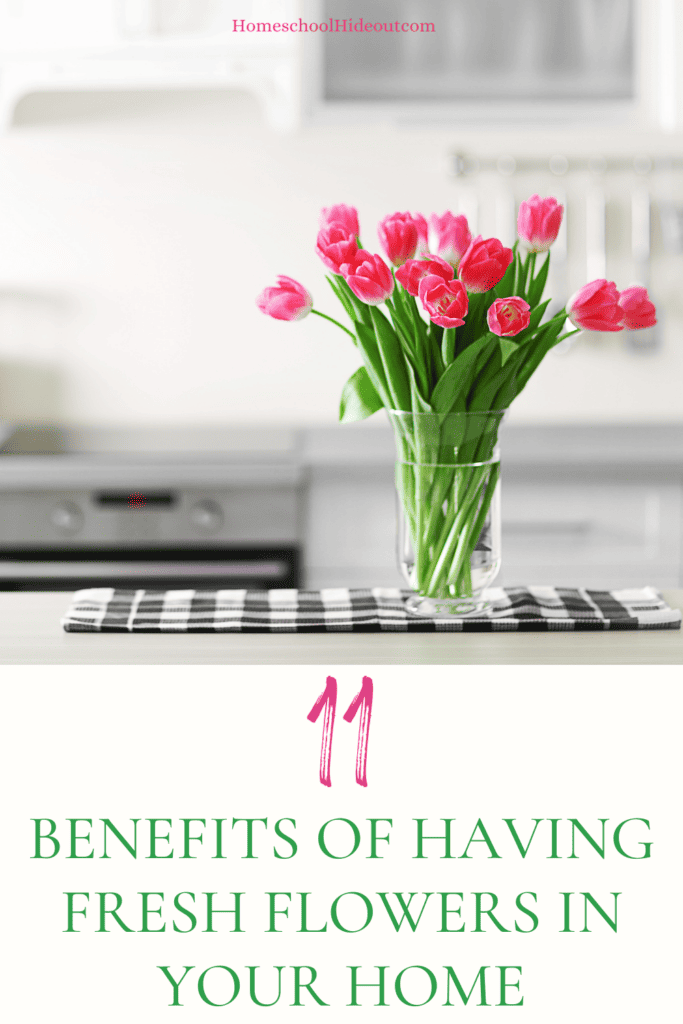Are there actual health benefits of having flowers in your home?
Your home serves as a sanctuary, a refuge where you find solace and tranquility. It’s a space uniquely your own, a haven from the chaos of the outside world.
Given the importance of your living environment, why not take the opportunity to elevate it by inviting the enchanting beauty of the natural world indoors?
Incorporating flowers into your home decor is a wonderful way to breathe new life into any room, and it offers numerous advantages beyond aesthetic appeal.
By embracing these beautiful blooms, you freshen up your living spaces and create an atmosphere that fosters well-being and harmony.
If you want these perfect blooms right at your doorstep, avail the services of same day flower delivery in Anchorage.
That said, let’s move forward with some of the benefits of having flowers in your home.
Benefits Of Having Flowers In Your Home
Flowers in your home can offer numerous emotional and health benefits, making them more than just decorative elements.
Here are some of the positive impacts of having flowers in your living space:
Emotional Benefits
Happiness and Joy
Happiness and joy are profound emotional states that flowers can remarkably evoke. The sight of fresh, colorful blooms can trigger an immediate surge of positivity and contentment.
These radiant blossoms symbolize the beauty and optimism of life, and their presence has a unique power to uplift our spirits. The vibrant colors, delicate petals, and exquisite fragrances of flowers elicit a sense of wonder and delight, sparking happiness and joy.
Whether displayed in a bouquet, a vase, or as part of your home decor, flowers can infuse your surroundings with positivity, reminding us of the simple and beautiful aspects of life that bring us immense happiness and joy.
Enhanced Mood
The enhanced mood is one of the flowers’ remarkable effects on our emotional well-being. The presence of flowers in our surroundings can work as a natural mood booster, brightening our spirits and reducing feelings of anxiety or stress.
Flowers’ vibrant colors and graceful forms
stimulate a sense of delight and optimism. Their innate beauty transcends the ordinary, creating an environment that exudes positivity and tranquility.
Whether you place them in your living space, office, or personal sanctuary, flowers uniquely elicit a heightened sense of emotional well-being, providing an uplifting and serene backdrop to our lives.
Connection to Nature
Connection to nature is a profound emotional benefit that flowers bring into our homes. Incorporating flowers within our living spaces bridges the gap between the indoors and the natural world, fostering a sense of harmony and unity with the environment.
The presence of flowers is a gentle reminder of the
the beauty and serenity of the outdoors, particularly in urban settings where nature may be less accessible. This connection can evoke feelings of peace and grounding and help us re-establish our bond with the Earth.
It instills a sense of appreciation for the cycles of life and the ever-changing seasons, reminding us of our place within the broader ecosystem.
Flowers, in their delicate and intricate forms, offer us a daily opportunity to bring the outdoors in, rekindling our connection to the world’s natural wonders.
Expressing Love and Affection
Flowers have long been a symbol of love and affection, making them a timeless and universal language for expressing deep emotions. Whether celebrating a special occasion, consoling a friend, or simply conveying your love, a carefully chosen bouquet can speak volumes.
Giving flowers is a heartfelt gesture transcending words, communicating your affection, appreciation, or sympathy gracefully and sincerely. The recipient of these blooms often feels cherished and connected to the sender on a profound emotional level.
From the romantic red roses that signify passionate love to the delicate lilies that convey purity and sympathy, flowers offer diverse options to express a spectrum of emotions, making them a beautiful and enduring means of sharing love and affection.
Enhanced Social Interaction
Flowers in your home have a subtle yet powerful impact on enhancing social interaction. Beautiful blooms create an inviting and warm atmosphere, making your living space more appealing to guests and loved ones.
Whether you’re hosting a gathering, a dinner party, or a simple get-together, flowers can act as conversation starters and icebreakers, encouraging people to engage and connect. Their aesthetic beauty is a common point of admiration and appreciation, prompting discussions about colors, fragrances, and personal preferences.
Furthermore, gifting flowers to someone is a universal gesture of affection and hospitality, strengthening social bonds and demonstrating thoughtfulness.
Thus, flowers serve as silent but effective facilitators of social interaction, fostering meaningful connections and shared moments of joy.

Health Benefits
Improved Mental Health
The presence of flowers in your home can significantly impact your mental health, leading to improved emotional well-being.
Flowers’ vibrant colors, pleasing scents, and natural beauty provide an instant mood boost. Their visual appeal fosters a sense of happiness and contentment, helping to reduce symptoms of depression and anxiety.
Caring for and tending to flowers can also be a soothing and stress-relieving activity, promoting relaxation and mindfulness. This connection to nature within your living space creates a serene and harmonious environment, reducing restlessness and enhancing mental clarity.
Overall, the enhanced mental health benefits of having flowers in your home highlight the power of nature to lift your spirits and create a more positive and emotionally fulfilling living space.
Stress Reduction
The presence of flowers in your home can serve as a powerful tool for stress reduction. Flowers have a calming effect on the mind, helping to alleviate anxiety and tension. Their vibrant colors and pleasant fragrances create a soothing and tranquil atmosphere, promoting relaxation and emotional well-being.
Taking the time to care for and arrange flowers can be a meditative and stress-relieving activity, offering a temporary escape from the demands of everyday life.
Tending to these blooms encourages mindfulness and presence in the moment, reducing restlessness and promoting mental clarity.
In essence, flowers’ simple yet profound influence on stress reduction underscores their ability to create a serene and peaceful living space that supports our emotional health.
Better Sleep Quality
Having flowers in your home can contribute to better sleep quality, particularly when certain fragrant flowers are present.
For example, the scent of lavender, known for its calming properties, can promote relaxation and reduce insomnia, allowing for a more restful night’s sleep.
Flowers in your bedroom create a soothing and serene ambiance, encouraging your mind and body to unwind. Their visual appeal also helps create a tranquil atmosphere conducive to better sleep.
As you breathe in the natural fragrances and admire the beauty of the blooms, you can drift off to sleep more easily, experiencing a deeper and more rejuvenating slumber.
The combination of visual and aromatic elements in flowers offers a multi-sensory approach to improving your sleep quality, making them a valuable addition to your bedroom decor.
Improved Air Quality
The presence of certain flowers and plants in your home can lead to improved air quality. Some varieties, like peace lilies and snake plants, are known for purifying the air by absorbing common indoor pollutants and releasing oxygen.
This natural air-cleaning effect helps reduce toxins and allergens in your living space, leading to better respiratory health. Cleaner air can alleviate allergies, asthma, and respiratory irritations, contributing to overall well-being.
By introducing these air-purifying plants and flowers into your home, you not only enhance the aesthetic appeal of your surroundings but also create an environment that supports better indoor air quality and, consequently, better health.
Boosted Immune System
Flowers in your home can indirectly contribute to a boosted immune system by impacting emotional well-being. The positive emotional state induced by flowers, such as reduced stress, improved mood, and enhanced creativity, can have a ripple effect on your physical health.
Reduced stress levels support a healthier immune system, making your body more resilient to illness. As your emotional well-being improves, your immune system’s ability to fend off infections and diseases is enhanced.
While flowers don’t provide direct immunity, they create an emotional environment that indirectly contributes to a more robust immune system, helping you stay healthier and more resistant to common ailments.
Pain Management
Flowers can play a role in pain management and alleviate discomfort during the recovery process from surgery or illness. While they are not a substitute for medical treatment, their presence can have a soothing effect on patients.
The calming influence of flowers can help reduce stress and anxiety, often associated with pain and discomfort. Engaging with flowers, such as arranging or caring for them, can be a mindful and distracting activity that shifts focus away from pain, offering temporary relief.
Furthermore, the enhanced emotional state fostered by flowers can reduce the need for pain medication, as a more positive and relaxed mental state can impact pain perception.
Although flowers are not a replacement for medical care, they can complement a holistic approach to pain management and recovery.

How To Keep Flowers Fresh?
Maintaining the freshness of your floral arrangements is a step-by-step process that ensures your blooms stay vibrant and beautiful.
Here’s a concise guide on how to keep your flowers fresh:
Prepare Your Materials:
Gather all the necessary materials, including a clean vase or container, sharp scissors or a knife, flower food (if available), clean and fresh water, and a towel or paper towel for potential spills.
Start with a Clean Vase:
Ensure your vase is impeccably clean. Wash it thoroughly with soap and warm water, then rinse it to remove any lingering bacteria or residue. A clean vase is essential for preserving the flowers’ freshness.
Trim the Stems:
Using sharp scissors or a knife, trim the stems of your flowers at a 45-degree angle. This angle provides a larger surface area for water absorption, which is crucial for maintaining their vitality. Trim at least one inch off the bottom of the stems.
Remove Submerged Leaves:
Identify and remove any leaves on the flower stems that would be submerged in the water. These submerged leaves can encourage the growth of bacteria, which can shorten the lifespan of your flowers.
Prepare the Water:
Fill your cleaned vase with fresh, cool water. If you have flower food, follow the package instructions to add it to the water. Without flower food, you can create your own by mixing a teaspoon of sugar with a few drops of bleach or white vinegar in the water.
Place the Flowers in the Vase:
Immediately place your trimmed flowers into the vase with the prepared water. Ensure that no leaves touch the water, which can lead to bacterial growth.
Regularly Change the Water:
Change the water in the vase every two days. Fresh water helps prevent bacterial growth and keeps the flowers adequately hydrated.
Maintain an Ideal Environment:
Position the vase in a cool room, away from direct sunlight, heating vents, and drafts. A cooler environment will help extend the freshness of your flowers.
Re-trim the Stems:
Each time you change the water, re-trim the stems at a 45-degree angle. This simple act refreshes the cut and maintains the flowers’ ability to absorb water.
Mist the Flowers:
Occasionally, lightly mist the flowers with water to keep them hydrated and looking fresh. This is particularly beneficial for certain flower types, such as roses.
Remove Wilting Flowers:
As some flowers wilt, promptly remove them from the arrangement. This prevents ethylene gas production, which can shorten the life of other flowers.
Avoid Fruits:
Steer clear of placing fruits near your flowers, as fruits release ethylene gas, which can accelerate wilting.
Consider Re-Arranging:
If you notice specific flowers fading faster than others, consider re-arranging the bouquet with fresh water and a new trim for the remaining blooms.
Conclusion
The presence of flowers in your home goes beyond mere decoration. It serves as a source of emotional and health benefits that enrich your living environment.
The captivating beauty of flowers enhances your mood, reduces stress, and fosters a deeper connection to the natural world. They create a soothing ambiance that promotes relaxation, mindfulness, and improved mental health.
Additionally, flowers can elevate your home’s aesthetics and foster social interactions, celebrating love, affection, and shared moments of joy.
On the health front, they contribute to cleaner indoor air, better sleep quality, and even support your immune system.
Thus, adorning your home with flowers is an aesthetic choice that enhances your overall well-being, cultivating a harmonious, serene, and inspiring atmosphere within your sanctuary.







